KIA Motors: Stakeholder and General Force Analysis Report
VerifiedAdded on 2023/06/15
|13
|3154
|158
Case Study
AI Summary
This case study provides a comprehensive stakeholder and general force analysis for KIA Motors, offering actionable recommendations to enhance its global performance. The analysis focuses on improving global performance through effective HR strategies, developing successful sales strategies, and optimizing the supply chain to meet new market needs. Measurable metrics are suggested for each recommendation, including employee surveys, productivity monitoring, sales goal analysis, and supply chain efficiency assessments. The study also addresses potential challenges in implementing these strategies, such as cost control, risk management, and inconsistent engagement levels. The SMART framework is applied to ensure that objectives are specific, measurable, attainable, realistic, and tangible, ultimately aiming to secure a sustainable competitive advantage for KIA Motors in the global automobile market. Desklib offers more solved assignments and past papers for students.
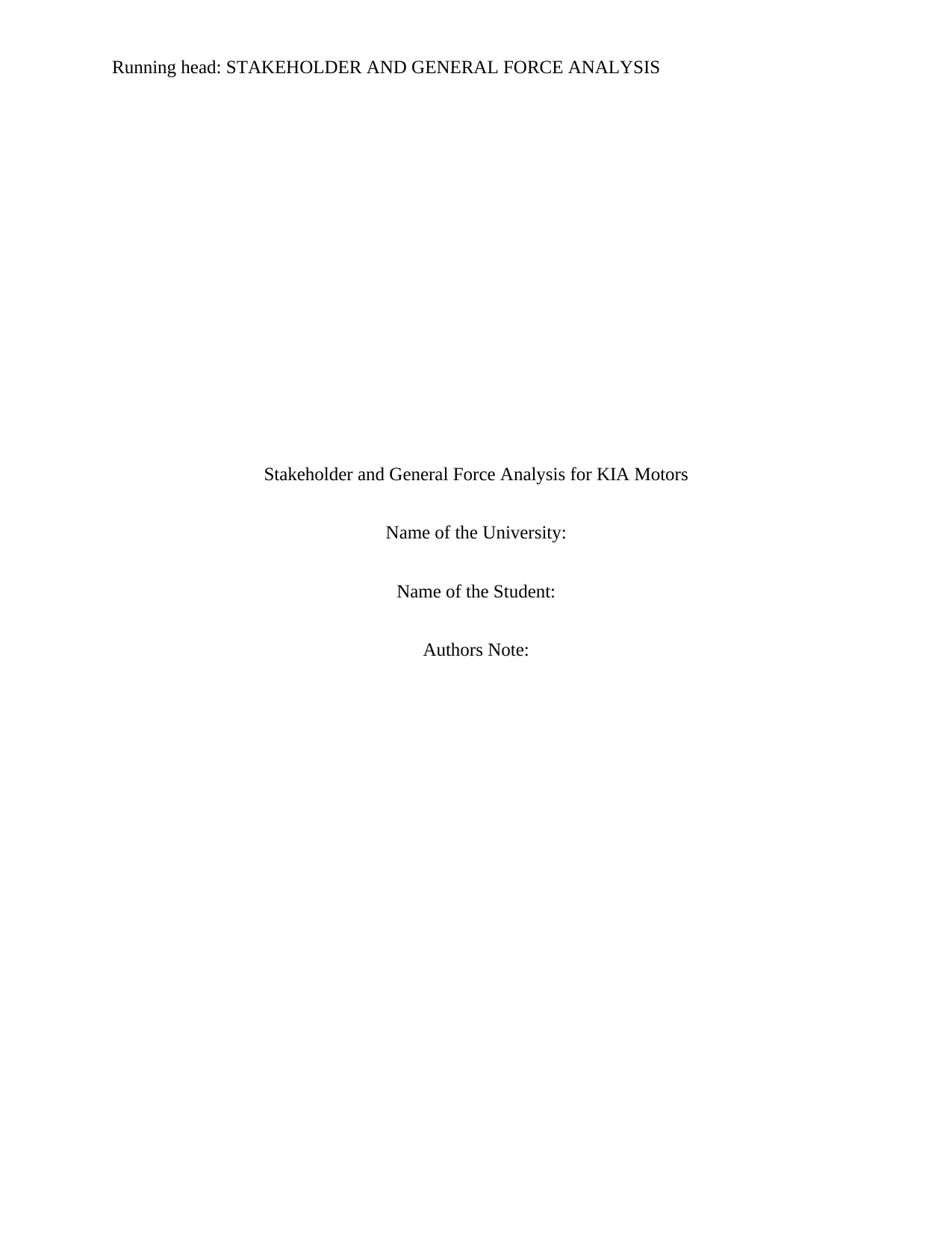
Running head: STAKEHOLDER AND GENERAL FORCE ANALYSIS
Stakeholder and General Force Analysis for KIA Motors
Name of the University:
Name of the Student:
Authors Note:
Stakeholder and General Force Analysis for KIA Motors
Name of the University:
Name of the Student:
Authors Note:
Paraphrase This Document
Need a fresh take? Get an instant paraphrase of this document with our AI Paraphraser
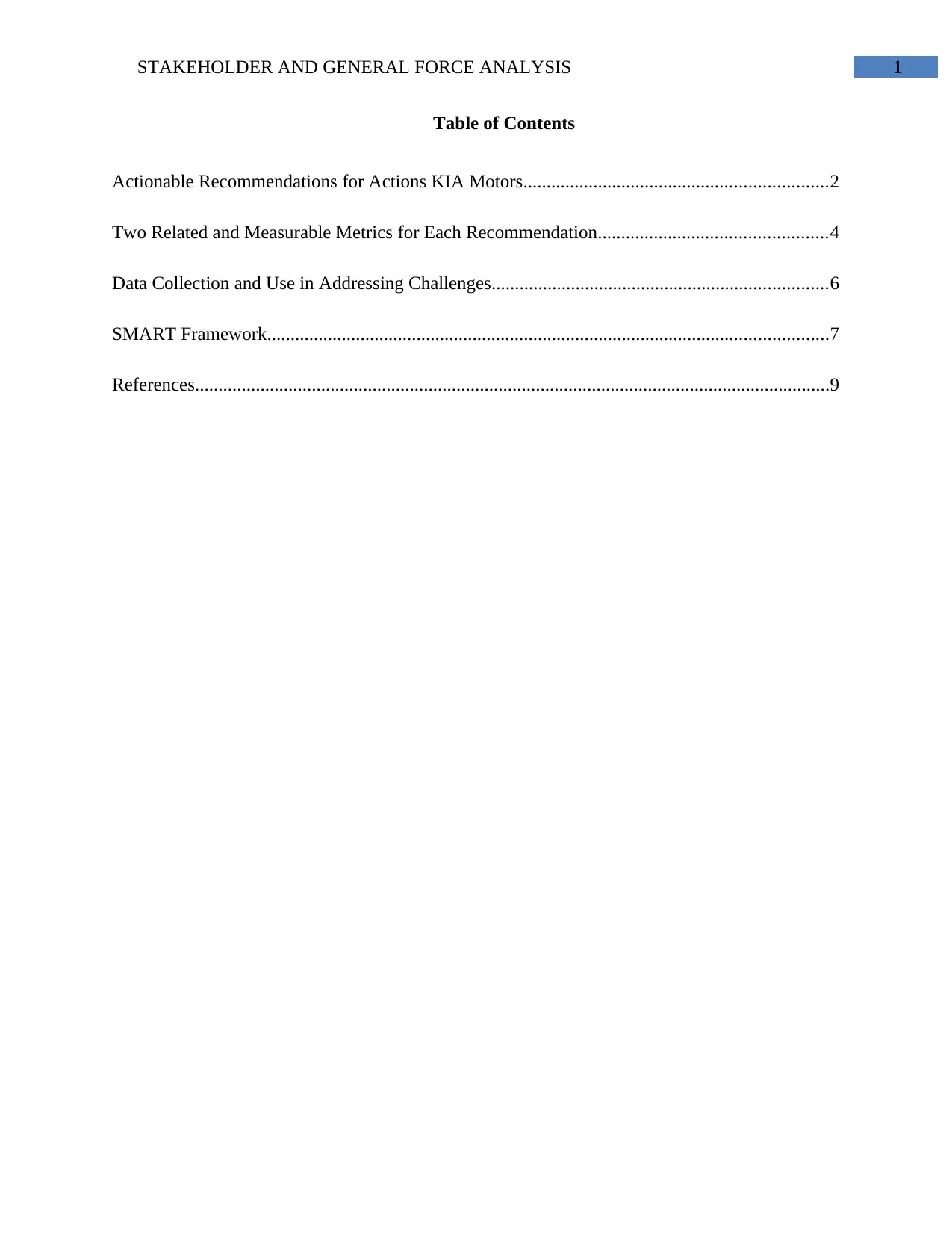
1STAKEHOLDER AND GENERAL FORCE ANALYSIS
Table of Contents
Actionable Recommendations for Actions KIA Motors.................................................................2
Two Related and Measurable Metrics for Each Recommendation.................................................4
Data Collection and Use in Addressing Challenges........................................................................6
SMART Framework........................................................................................................................7
References........................................................................................................................................9
Table of Contents
Actionable Recommendations for Actions KIA Motors.................................................................2
Two Related and Measurable Metrics for Each Recommendation.................................................4
Data Collection and Use in Addressing Challenges........................................................................6
SMART Framework........................................................................................................................7
References........................................................................................................................................9
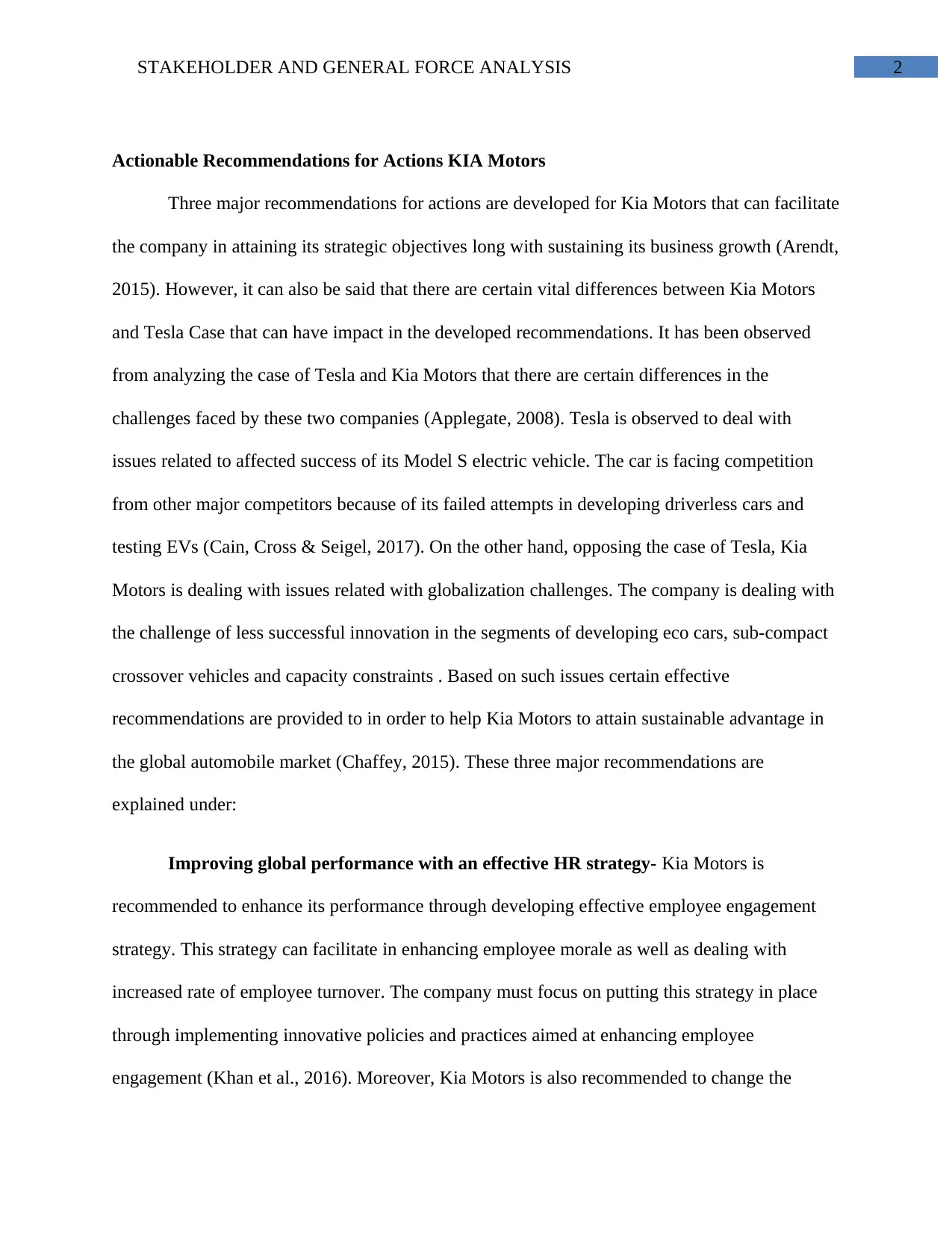
2STAKEHOLDER AND GENERAL FORCE ANALYSIS
Actionable Recommendations for Actions KIA Motors
Three major recommendations for actions are developed for Kia Motors that can facilitate
the company in attaining its strategic objectives long with sustaining its business growth (Arendt,
2015). However, it can also be said that there are certain vital differences between Kia Motors
and Tesla Case that can have impact in the developed recommendations. It has been observed
from analyzing the case of Tesla and Kia Motors that there are certain differences in the
challenges faced by these two companies (Applegate, 2008). Tesla is observed to deal with
issues related to affected success of its Model S electric vehicle. The car is facing competition
from other major competitors because of its failed attempts in developing driverless cars and
testing EVs (Cain, Cross & Seigel, 2017). On the other hand, opposing the case of Tesla, Kia
Motors is dealing with issues related with globalization challenges. The company is dealing with
the challenge of less successful innovation in the segments of developing eco cars, sub-compact
crossover vehicles and capacity constraints . Based on such issues certain effective
recommendations are provided to in order to help Kia Motors to attain sustainable advantage in
the global automobile market (Chaffey, 2015). These three major recommendations are
explained under:
Improving global performance with an effective HR strategy- Kia Motors is
recommended to enhance its performance through developing effective employee engagement
strategy. This strategy can facilitate in enhancing employee morale as well as dealing with
increased rate of employee turnover. The company must focus on putting this strategy in place
through implementing innovative policies and practices aimed at enhancing employee
engagement (Khan et al., 2016). Moreover, Kia Motors is also recommended to change the
Actionable Recommendations for Actions KIA Motors
Three major recommendations for actions are developed for Kia Motors that can facilitate
the company in attaining its strategic objectives long with sustaining its business growth (Arendt,
2015). However, it can also be said that there are certain vital differences between Kia Motors
and Tesla Case that can have impact in the developed recommendations. It has been observed
from analyzing the case of Tesla and Kia Motors that there are certain differences in the
challenges faced by these two companies (Applegate, 2008). Tesla is observed to deal with
issues related to affected success of its Model S electric vehicle. The car is facing competition
from other major competitors because of its failed attempts in developing driverless cars and
testing EVs (Cain, Cross & Seigel, 2017). On the other hand, opposing the case of Tesla, Kia
Motors is dealing with issues related with globalization challenges. The company is dealing with
the challenge of less successful innovation in the segments of developing eco cars, sub-compact
crossover vehicles and capacity constraints . Based on such issues certain effective
recommendations are provided to in order to help Kia Motors to attain sustainable advantage in
the global automobile market (Chaffey, 2015). These three major recommendations are
explained under:
Improving global performance with an effective HR strategy- Kia Motors is
recommended to enhance its performance through developing effective employee engagement
strategy. This strategy can facilitate in enhancing employee morale as well as dealing with
increased rate of employee turnover. The company must focus on putting this strategy in place
through implementing innovative policies and practices aimed at enhancing employee
engagement (Khan et al., 2016). Moreover, Kia Motors is also recommended to change the
⊘ This is a preview!⊘
Do you want full access?
Subscribe today to unlock all pages.

Trusted by 1+ million students worldwide
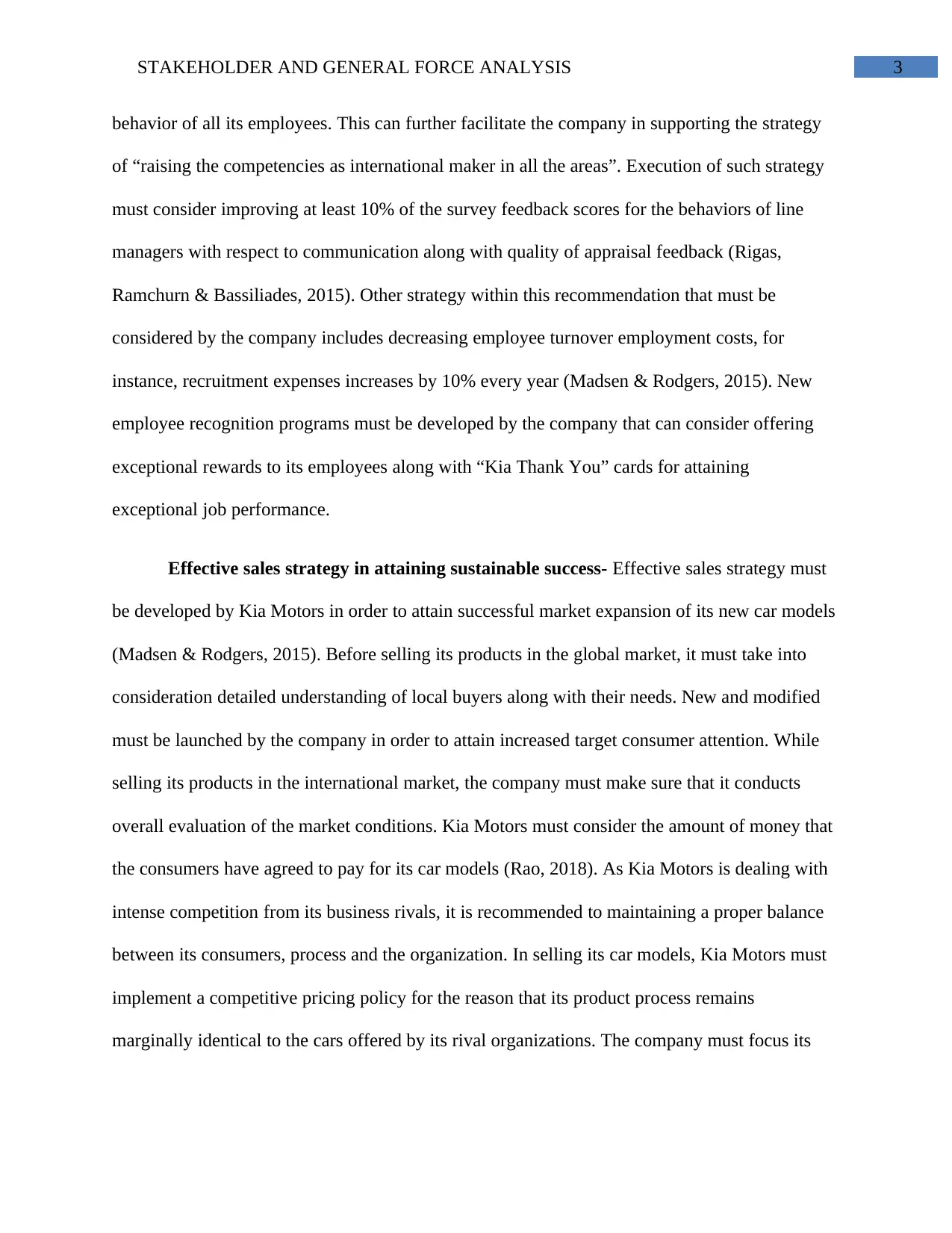
3STAKEHOLDER AND GENERAL FORCE ANALYSIS
behavior of all its employees. This can further facilitate the company in supporting the strategy
of “raising the competencies as international maker in all the areas”. Execution of such strategy
must consider improving at least 10% of the survey feedback scores for the behaviors of line
managers with respect to communication along with quality of appraisal feedback (Rigas,
Ramchurn & Bassiliades, 2015). Other strategy within this recommendation that must be
considered by the company includes decreasing employee turnover employment costs, for
instance, recruitment expenses increases by 10% every year (Madsen & Rodgers, 2015). New
employee recognition programs must be developed by the company that can consider offering
exceptional rewards to its employees along with “Kia Thank You” cards for attaining
exceptional job performance.
Effective sales strategy in attaining sustainable success- Effective sales strategy must
be developed by Kia Motors in order to attain successful market expansion of its new car models
(Madsen & Rodgers, 2015). Before selling its products in the global market, it must take into
consideration detailed understanding of local buyers along with their needs. New and modified
must be launched by the company in order to attain increased target consumer attention. While
selling its products in the international market, the company must make sure that it conducts
overall evaluation of the market conditions. Kia Motors must consider the amount of money that
the consumers have agreed to pay for its car models (Rao, 2018). As Kia Motors is dealing with
intense competition from its business rivals, it is recommended to maintaining a proper balance
between its consumers, process and the organization. In selling its car models, Kia Motors must
implement a competitive pricing policy for the reason that its product process remains
marginally identical to the cars offered by its rival organizations. The company must focus its
behavior of all its employees. This can further facilitate the company in supporting the strategy
of “raising the competencies as international maker in all the areas”. Execution of such strategy
must consider improving at least 10% of the survey feedback scores for the behaviors of line
managers with respect to communication along with quality of appraisal feedback (Rigas,
Ramchurn & Bassiliades, 2015). Other strategy within this recommendation that must be
considered by the company includes decreasing employee turnover employment costs, for
instance, recruitment expenses increases by 10% every year (Madsen & Rodgers, 2015). New
employee recognition programs must be developed by the company that can consider offering
exceptional rewards to its employees along with “Kia Thank You” cards for attaining
exceptional job performance.
Effective sales strategy in attaining sustainable success- Effective sales strategy must
be developed by Kia Motors in order to attain successful market expansion of its new car models
(Madsen & Rodgers, 2015). Before selling its products in the global market, it must take into
consideration detailed understanding of local buyers along with their needs. New and modified
must be launched by the company in order to attain increased target consumer attention. While
selling its products in the international market, the company must make sure that it conducts
overall evaluation of the market conditions. Kia Motors must consider the amount of money that
the consumers have agreed to pay for its car models (Rao, 2018). As Kia Motors is dealing with
intense competition from its business rivals, it is recommended to maintaining a proper balance
between its consumers, process and the organization. In selling its car models, Kia Motors must
implement a competitive pricing policy for the reason that its product process remains
marginally identical to the cars offered by its rival organizations. The company must focus its
Paraphrase This Document
Need a fresh take? Get an instant paraphrase of this document with our AI Paraphraser
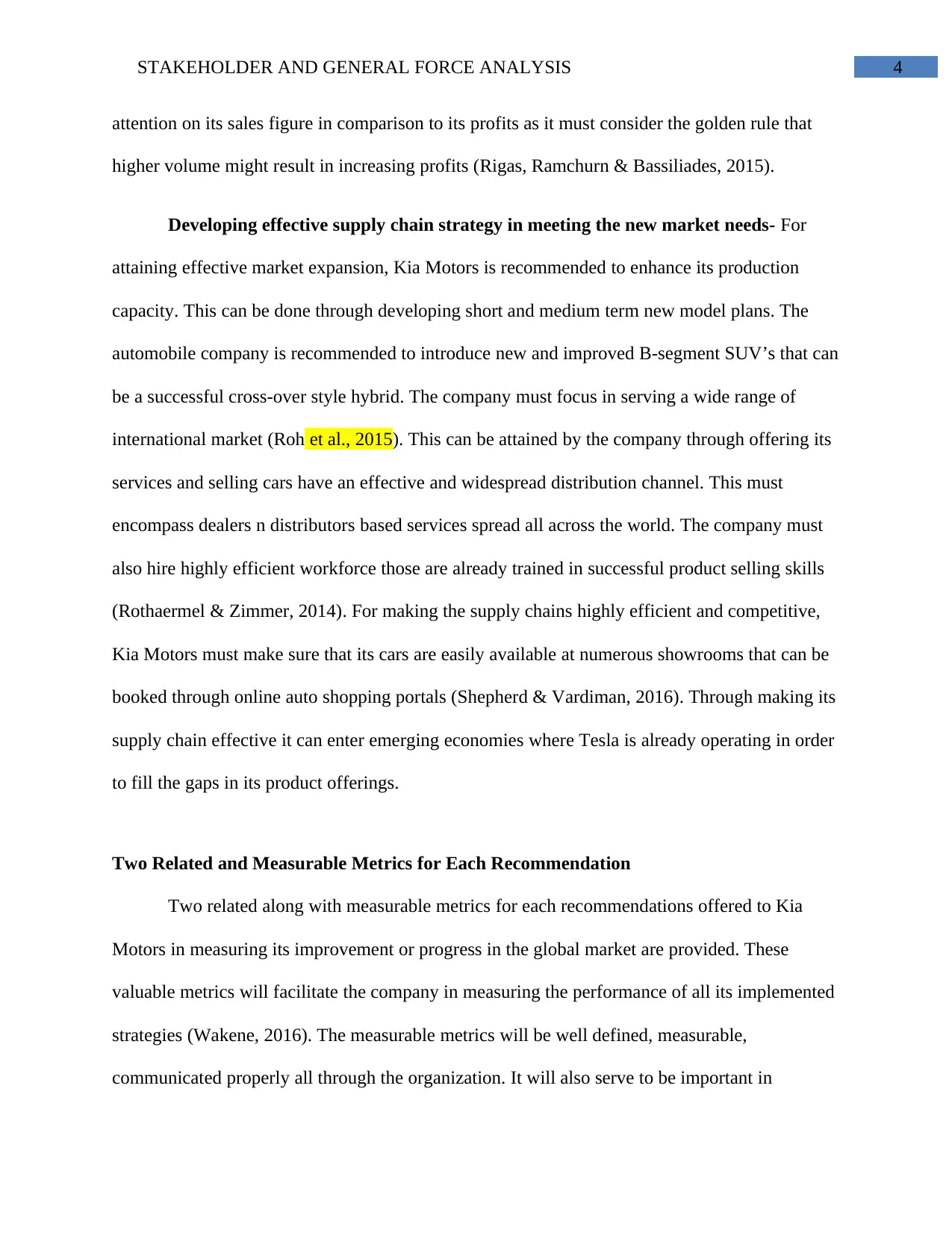
4STAKEHOLDER AND GENERAL FORCE ANALYSIS
attention on its sales figure in comparison to its profits as it must consider the golden rule that
higher volume might result in increasing profits (Rigas, Ramchurn & Bassiliades, 2015).
Developing effective supply chain strategy in meeting the new market needs- For
attaining effective market expansion, Kia Motors is recommended to enhance its production
capacity. This can be done through developing short and medium term new model plans. The
automobile company is recommended to introduce new and improved B-segment SUV’s that can
be a successful cross-over style hybrid. The company must focus in serving a wide range of
international market (Roh et al., 2015). This can be attained by the company through offering its
services and selling cars have an effective and widespread distribution channel. This must
encompass dealers n distributors based services spread all across the world. The company must
also hire highly efficient workforce those are already trained in successful product selling skills
(Rothaermel & Zimmer, 2014). For making the supply chains highly efficient and competitive,
Kia Motors must make sure that its cars are easily available at numerous showrooms that can be
booked through online auto shopping portals (Shepherd & Vardiman, 2016). Through making its
supply chain effective it can enter emerging economies where Tesla is already operating in order
to fill the gaps in its product offerings.
Two Related and Measurable Metrics for Each Recommendation
Two related along with measurable metrics for each recommendations offered to Kia
Motors in measuring its improvement or progress in the global market are provided. These
valuable metrics will facilitate the company in measuring the performance of all its implemented
strategies (Wakene, 2016). The measurable metrics will be well defined, measurable,
communicated properly all through the organization. It will also serve to be important in
attention on its sales figure in comparison to its profits as it must consider the golden rule that
higher volume might result in increasing profits (Rigas, Ramchurn & Bassiliades, 2015).
Developing effective supply chain strategy in meeting the new market needs- For
attaining effective market expansion, Kia Motors is recommended to enhance its production
capacity. This can be done through developing short and medium term new model plans. The
automobile company is recommended to introduce new and improved B-segment SUV’s that can
be a successful cross-over style hybrid. The company must focus in serving a wide range of
international market (Roh et al., 2015). This can be attained by the company through offering its
services and selling cars have an effective and widespread distribution channel. This must
encompass dealers n distributors based services spread all across the world. The company must
also hire highly efficient workforce those are already trained in successful product selling skills
(Rothaermel & Zimmer, 2014). For making the supply chains highly efficient and competitive,
Kia Motors must make sure that its cars are easily available at numerous showrooms that can be
booked through online auto shopping portals (Shepherd & Vardiman, 2016). Through making its
supply chain effective it can enter emerging economies where Tesla is already operating in order
to fill the gaps in its product offerings.
Two Related and Measurable Metrics for Each Recommendation
Two related along with measurable metrics for each recommendations offered to Kia
Motors in measuring its improvement or progress in the global market are provided. These
valuable metrics will facilitate the company in measuring the performance of all its implemented
strategies (Wakene, 2016). The measurable metrics will be well defined, measurable,
communicated properly all through the organization. It will also serve to be important in
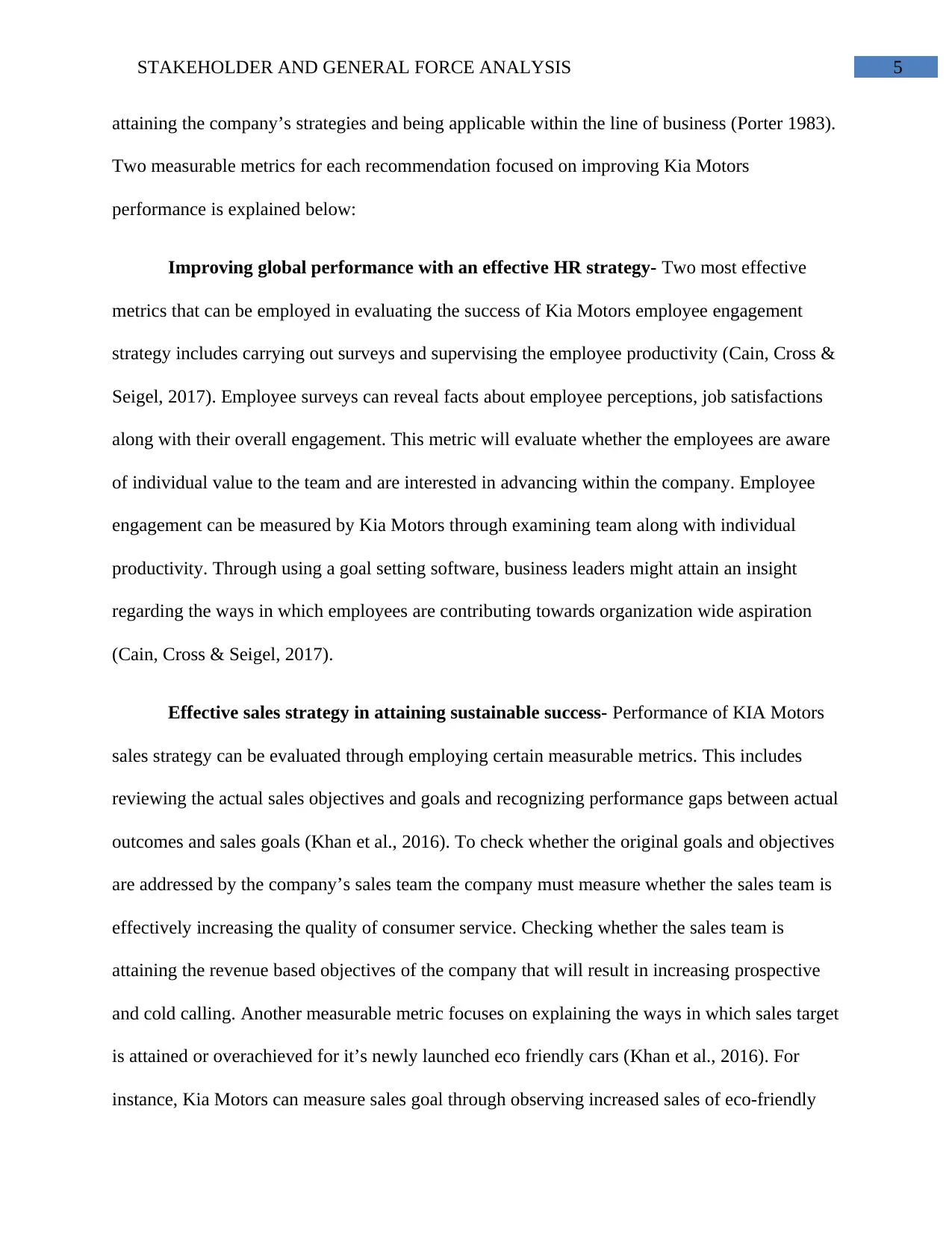
5STAKEHOLDER AND GENERAL FORCE ANALYSIS
attaining the company’s strategies and being applicable within the line of business (Porter 1983).
Two measurable metrics for each recommendation focused on improving Kia Motors
performance is explained below:
Improving global performance with an effective HR strategy- Two most effective
metrics that can be employed in evaluating the success of Kia Motors employee engagement
strategy includes carrying out surveys and supervising the employee productivity (Cain, Cross &
Seigel, 2017). Employee surveys can reveal facts about employee perceptions, job satisfactions
along with their overall engagement. This metric will evaluate whether the employees are aware
of individual value to the team and are interested in advancing within the company. Employee
engagement can be measured by Kia Motors through examining team along with individual
productivity. Through using a goal setting software, business leaders might attain an insight
regarding the ways in which employees are contributing towards organization wide aspiration
(Cain, Cross & Seigel, 2017).
Effective sales strategy in attaining sustainable success- Performance of KIA Motors
sales strategy can be evaluated through employing certain measurable metrics. This includes
reviewing the actual sales objectives and goals and recognizing performance gaps between actual
outcomes and sales goals (Khan et al., 2016). To check whether the original goals and objectives
are addressed by the company’s sales team the company must measure whether the sales team is
effectively increasing the quality of consumer service. Checking whether the sales team is
attaining the revenue based objectives of the company that will result in increasing prospective
and cold calling. Another measurable metric focuses on explaining the ways in which sales target
is attained or overachieved for it’s newly launched eco friendly cars (Khan et al., 2016). For
instance, Kia Motors can measure sales goal through observing increased sales of eco-friendly
attaining the company’s strategies and being applicable within the line of business (Porter 1983).
Two measurable metrics for each recommendation focused on improving Kia Motors
performance is explained below:
Improving global performance with an effective HR strategy- Two most effective
metrics that can be employed in evaluating the success of Kia Motors employee engagement
strategy includes carrying out surveys and supervising the employee productivity (Cain, Cross &
Seigel, 2017). Employee surveys can reveal facts about employee perceptions, job satisfactions
along with their overall engagement. This metric will evaluate whether the employees are aware
of individual value to the team and are interested in advancing within the company. Employee
engagement can be measured by Kia Motors through examining team along with individual
productivity. Through using a goal setting software, business leaders might attain an insight
regarding the ways in which employees are contributing towards organization wide aspiration
(Cain, Cross & Seigel, 2017).
Effective sales strategy in attaining sustainable success- Performance of KIA Motors
sales strategy can be evaluated through employing certain measurable metrics. This includes
reviewing the actual sales objectives and goals and recognizing performance gaps between actual
outcomes and sales goals (Khan et al., 2016). To check whether the original goals and objectives
are addressed by the company’s sales team the company must measure whether the sales team is
effectively increasing the quality of consumer service. Checking whether the sales team is
attaining the revenue based objectives of the company that will result in increasing prospective
and cold calling. Another measurable metric focuses on explaining the ways in which sales target
is attained or overachieved for it’s newly launched eco friendly cars (Khan et al., 2016). For
instance, Kia Motors can measure sales goal through observing increased sales of eco-friendly
⊘ This is a preview!⊘
Do you want full access?
Subscribe today to unlock all pages.

Trusted by 1+ million students worldwide
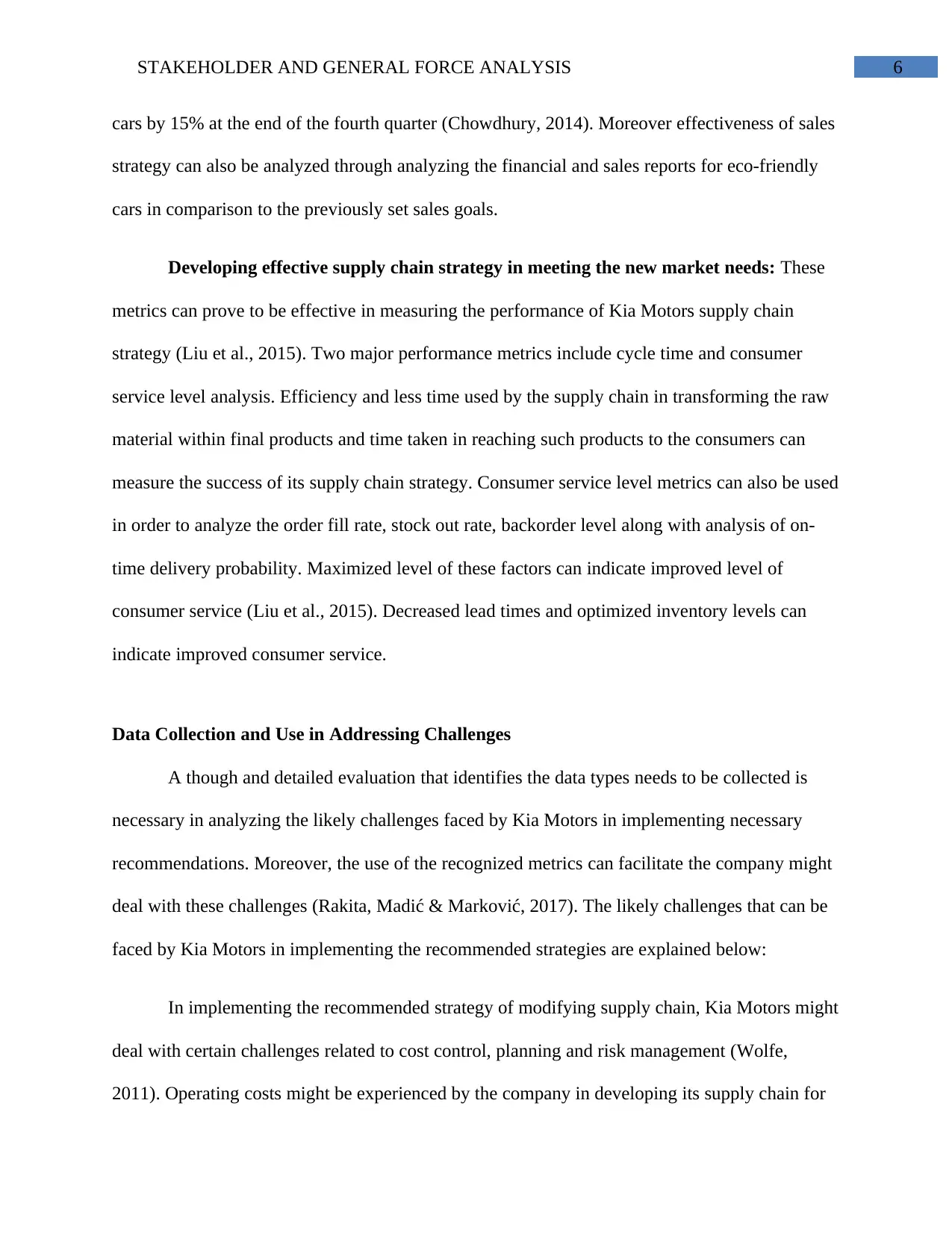
6STAKEHOLDER AND GENERAL FORCE ANALYSIS
cars by 15% at the end of the fourth quarter (Chowdhury, 2014). Moreover effectiveness of sales
strategy can also be analyzed through analyzing the financial and sales reports for eco-friendly
cars in comparison to the previously set sales goals.
Developing effective supply chain strategy in meeting the new market needs: These
metrics can prove to be effective in measuring the performance of Kia Motors supply chain
strategy (Liu et al., 2015). Two major performance metrics include cycle time and consumer
service level analysis. Efficiency and less time used by the supply chain in transforming the raw
material within final products and time taken in reaching such products to the consumers can
measure the success of its supply chain strategy. Consumer service level metrics can also be used
in order to analyze the order fill rate, stock out rate, backorder level along with analysis of on-
time delivery probability. Maximized level of these factors can indicate improved level of
consumer service (Liu et al., 2015). Decreased lead times and optimized inventory levels can
indicate improved consumer service.
Data Collection and Use in Addressing Challenges
A though and detailed evaluation that identifies the data types needs to be collected is
necessary in analyzing the likely challenges faced by Kia Motors in implementing necessary
recommendations. Moreover, the use of the recognized metrics can facilitate the company might
deal with these challenges (Rakita, Madić & Marković, 2017). The likely challenges that can be
faced by Kia Motors in implementing the recommended strategies are explained below:
In implementing the recommended strategy of modifying supply chain, Kia Motors might
deal with certain challenges related to cost control, planning and risk management (Wolfe,
2011). Operating costs might be experienced by the company in developing its supply chain for
cars by 15% at the end of the fourth quarter (Chowdhury, 2014). Moreover effectiveness of sales
strategy can also be analyzed through analyzing the financial and sales reports for eco-friendly
cars in comparison to the previously set sales goals.
Developing effective supply chain strategy in meeting the new market needs: These
metrics can prove to be effective in measuring the performance of Kia Motors supply chain
strategy (Liu et al., 2015). Two major performance metrics include cycle time and consumer
service level analysis. Efficiency and less time used by the supply chain in transforming the raw
material within final products and time taken in reaching such products to the consumers can
measure the success of its supply chain strategy. Consumer service level metrics can also be used
in order to analyze the order fill rate, stock out rate, backorder level along with analysis of on-
time delivery probability. Maximized level of these factors can indicate improved level of
consumer service (Liu et al., 2015). Decreased lead times and optimized inventory levels can
indicate improved consumer service.
Data Collection and Use in Addressing Challenges
A though and detailed evaluation that identifies the data types needs to be collected is
necessary in analyzing the likely challenges faced by Kia Motors in implementing necessary
recommendations. Moreover, the use of the recognized metrics can facilitate the company might
deal with these challenges (Rakita, Madić & Marković, 2017). The likely challenges that can be
faced by Kia Motors in implementing the recommended strategies are explained below:
In implementing the recommended strategy of modifying supply chain, Kia Motors might
deal with certain challenges related to cost control, planning and risk management (Wolfe,
2011). Operating costs might be experienced by the company in developing its supply chain for
Paraphrase This Document
Need a fresh take? Get an instant paraphrase of this document with our AI Paraphraser
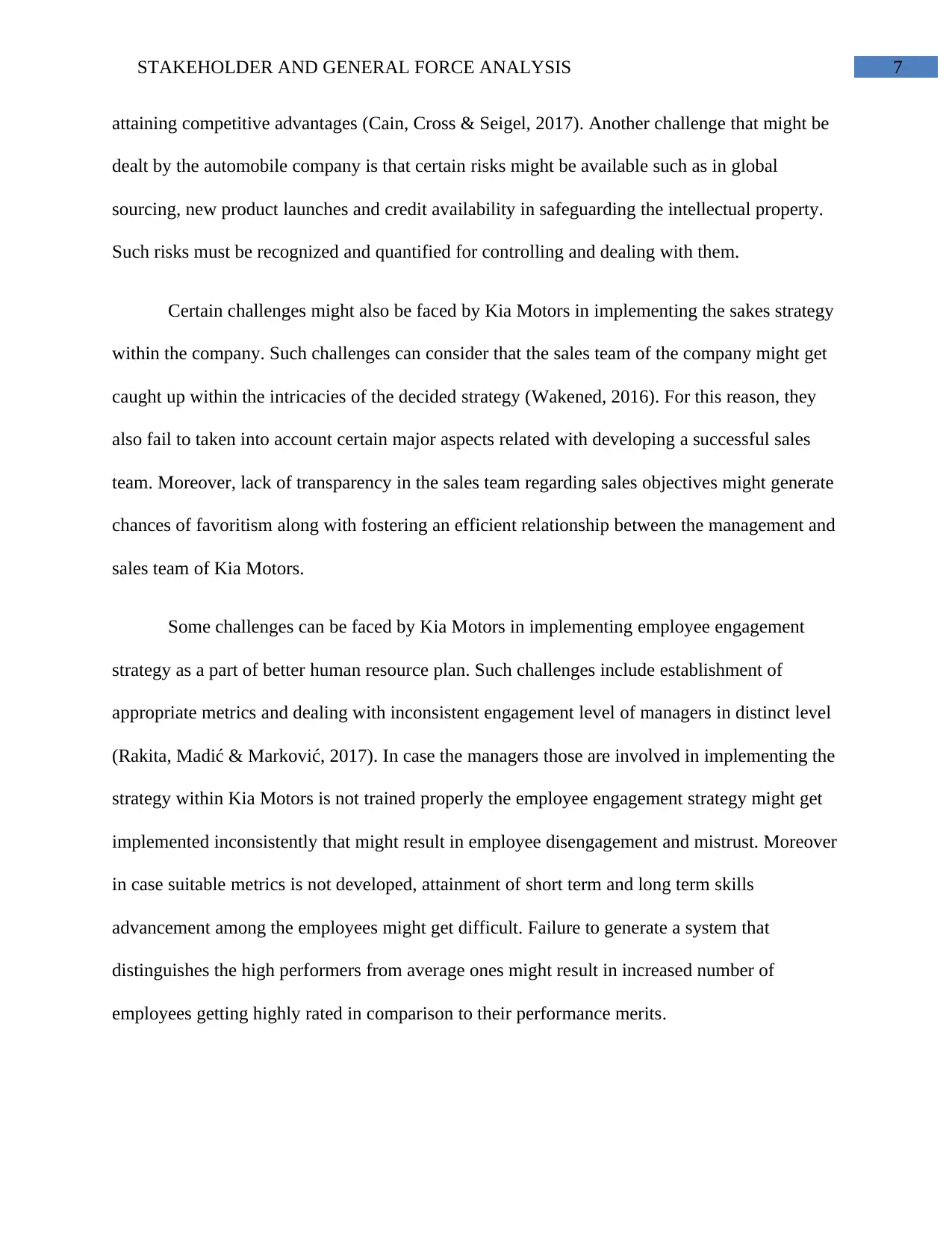
7STAKEHOLDER AND GENERAL FORCE ANALYSIS
attaining competitive advantages (Cain, Cross & Seigel, 2017). Another challenge that might be
dealt by the automobile company is that certain risks might be available such as in global
sourcing, new product launches and credit availability in safeguarding the intellectual property.
Such risks must be recognized and quantified for controlling and dealing with them.
Certain challenges might also be faced by Kia Motors in implementing the sakes strategy
within the company. Such challenges can consider that the sales team of the company might get
caught up within the intricacies of the decided strategy (Wakened, 2016). For this reason, they
also fail to taken into account certain major aspects related with developing a successful sales
team. Moreover, lack of transparency in the sales team regarding sales objectives might generate
chances of favoritism along with fostering an efficient relationship between the management and
sales team of Kia Motors.
Some challenges can be faced by Kia Motors in implementing employee engagement
strategy as a part of better human resource plan. Such challenges include establishment of
appropriate metrics and dealing with inconsistent engagement level of managers in distinct level
(Rakita, Madić & Marković, 2017). In case the managers those are involved in implementing the
strategy within Kia Motors is not trained properly the employee engagement strategy might get
implemented inconsistently that might result in employee disengagement and mistrust. Moreover
in case suitable metrics is not developed, attainment of short term and long term skills
advancement among the employees might get difficult. Failure to generate a system that
distinguishes the high performers from average ones might result in increased number of
employees getting highly rated in comparison to their performance merits.
attaining competitive advantages (Cain, Cross & Seigel, 2017). Another challenge that might be
dealt by the automobile company is that certain risks might be available such as in global
sourcing, new product launches and credit availability in safeguarding the intellectual property.
Such risks must be recognized and quantified for controlling and dealing with them.
Certain challenges might also be faced by Kia Motors in implementing the sakes strategy
within the company. Such challenges can consider that the sales team of the company might get
caught up within the intricacies of the decided strategy (Wakened, 2016). For this reason, they
also fail to taken into account certain major aspects related with developing a successful sales
team. Moreover, lack of transparency in the sales team regarding sales objectives might generate
chances of favoritism along with fostering an efficient relationship between the management and
sales team of Kia Motors.
Some challenges can be faced by Kia Motors in implementing employee engagement
strategy as a part of better human resource plan. Such challenges include establishment of
appropriate metrics and dealing with inconsistent engagement level of managers in distinct level
(Rakita, Madić & Marković, 2017). In case the managers those are involved in implementing the
strategy within Kia Motors is not trained properly the employee engagement strategy might get
implemented inconsistently that might result in employee disengagement and mistrust. Moreover
in case suitable metrics is not developed, attainment of short term and long term skills
advancement among the employees might get difficult. Failure to generate a system that
distinguishes the high performers from average ones might result in increased number of
employees getting highly rated in comparison to their performance merits.
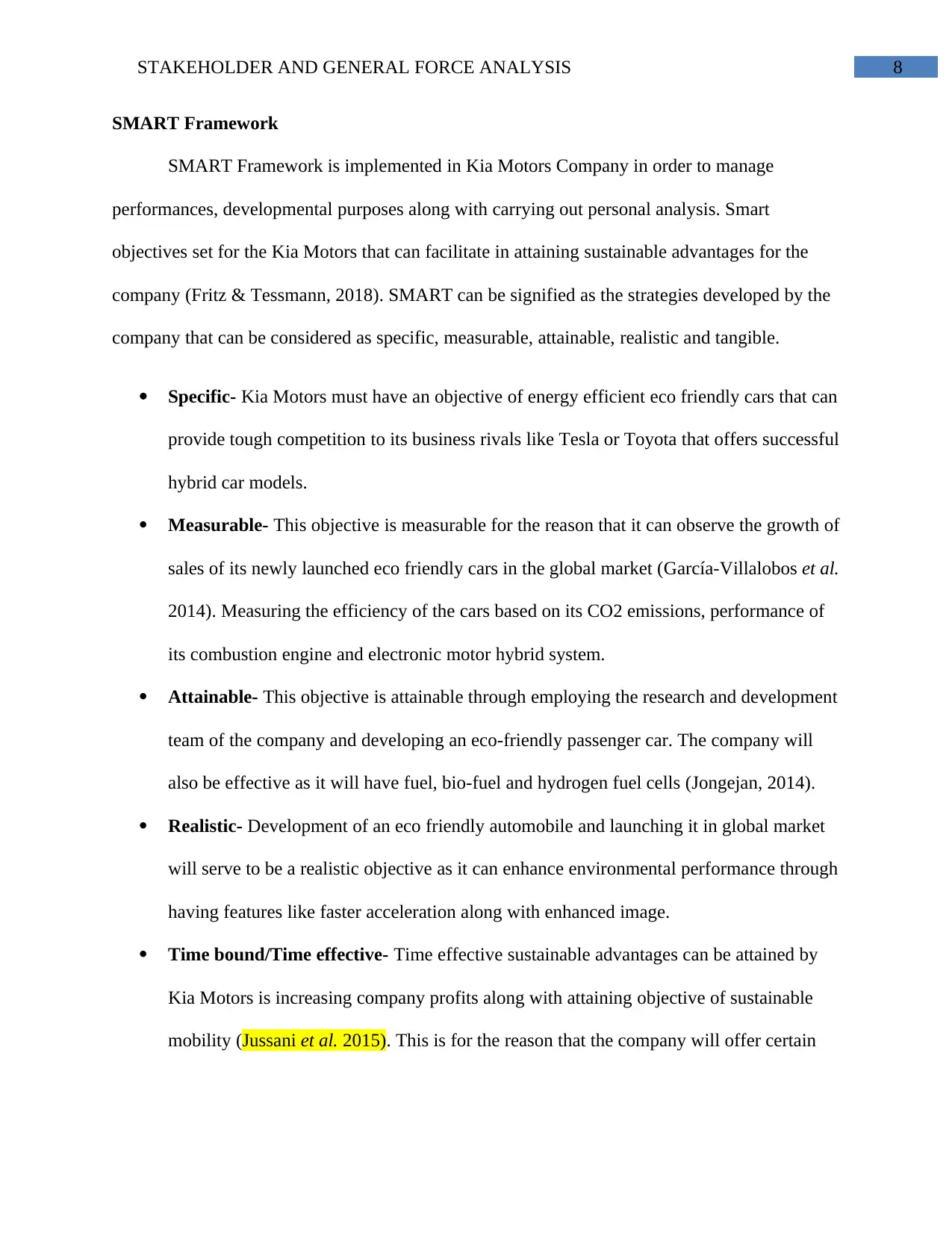
8STAKEHOLDER AND GENERAL FORCE ANALYSIS
SMART Framework
SMART Framework is implemented in Kia Motors Company in order to manage
performances, developmental purposes along with carrying out personal analysis. Smart
objectives set for the Kia Motors that can facilitate in attaining sustainable advantages for the
company (Fritz & Tessmann, 2018). SMART can be signified as the strategies developed by the
company that can be considered as specific, measurable, attainable, realistic and tangible.
Specific- Kia Motors must have an objective of energy efficient eco friendly cars that can
provide tough competition to its business rivals like Tesla or Toyota that offers successful
hybrid car models.
Measurable- This objective is measurable for the reason that it can observe the growth of
sales of its newly launched eco friendly cars in the global market (García-Villalobos et al.
2014). Measuring the efficiency of the cars based on its CO2 emissions, performance of
its combustion engine and electronic motor hybrid system.
Attainable- This objective is attainable through employing the research and development
team of the company and developing an eco-friendly passenger car. The company will
also be effective as it will have fuel, bio-fuel and hydrogen fuel cells (Jongejan, 2014).
Realistic- Development of an eco friendly automobile and launching it in global market
will serve to be a realistic objective as it can enhance environmental performance through
having features like faster acceleration along with enhanced image.
Time bound/Time effective- Time effective sustainable advantages can be attained by
Kia Motors is increasing company profits along with attaining objective of sustainable
mobility (Jussani et al. 2015). This is for the reason that the company will offer certain
SMART Framework
SMART Framework is implemented in Kia Motors Company in order to manage
performances, developmental purposes along with carrying out personal analysis. Smart
objectives set for the Kia Motors that can facilitate in attaining sustainable advantages for the
company (Fritz & Tessmann, 2018). SMART can be signified as the strategies developed by the
company that can be considered as specific, measurable, attainable, realistic and tangible.
Specific- Kia Motors must have an objective of energy efficient eco friendly cars that can
provide tough competition to its business rivals like Tesla or Toyota that offers successful
hybrid car models.
Measurable- This objective is measurable for the reason that it can observe the growth of
sales of its newly launched eco friendly cars in the global market (García-Villalobos et al.
2014). Measuring the efficiency of the cars based on its CO2 emissions, performance of
its combustion engine and electronic motor hybrid system.
Attainable- This objective is attainable through employing the research and development
team of the company and developing an eco-friendly passenger car. The company will
also be effective as it will have fuel, bio-fuel and hydrogen fuel cells (Jongejan, 2014).
Realistic- Development of an eco friendly automobile and launching it in global market
will serve to be a realistic objective as it can enhance environmental performance through
having features like faster acceleration along with enhanced image.
Time bound/Time effective- Time effective sustainable advantages can be attained by
Kia Motors is increasing company profits along with attaining objective of sustainable
mobility (Jussani et al. 2015). This is for the reason that the company will offer certain
⊘ This is a preview!⊘
Do you want full access?
Subscribe today to unlock all pages.

Trusted by 1+ million students worldwide

9STAKEHOLDER AND GENERAL FORCE ANALYSIS
time bound advantages such as fuel efficiency along with maximum cabin space and
compact design along with timely service delivery.
time bound advantages such as fuel efficiency along with maximum cabin space and
compact design along with timely service delivery.
Paraphrase This Document
Need a fresh take? Get an instant paraphrase of this document with our AI Paraphraser

10STAKEHOLDER AND GENERAL FORCE ANALYSIS
References
“Stakeholder Analysis tool” Applegate (2008)
“The living organization” by Wolfe (2011) chapter 8 page 93-97.
Arendt, C. (2015). A Tale of Two Crises: A Structurational-material Analysis of Forgotten
Stakeholders. Iowa Journal of Communication, 47.
Cain, P. W., Cross, M. D., & Seigel, R. A. (2017). Field Data and Stakeholders: Regulating the
Commercial Harvest of Snapping Turtles in Maryland. Chelonian Conservation and
Biology.
Chaffey, D. (2015). How to define SMART marketing objectives. Smart insights,[online]
Available at: http://www. smartinsights. com/goal-settingevaluation/goals-kpis/define-
smart-marketing-objectives/[Accessed: 1 March 2015].
Chowdhury, S. D. (2014). Strategic roads that diverge or converge: GM and Toyota in the battle
for the top.
Fritz, M. M., & Tessmann, N. (2018). Management of Conflict Minerals in Automotive Supply
Chains: Where to Start from?. In Social and Environmental Dimensions of Organizations
and Supply Chains (pp. 153-169). Springer, Cham.
García-Villalobos, J., Zamora, I., San Martín, J. I., Asensio, F. J., & Aperribay, V. (2014). Plug-
in electric vehicles in electric distribution networks: A review of smart charging
approaches. Renewable and Sustainable Energy Reviews, 38, 717-731.
References
“Stakeholder Analysis tool” Applegate (2008)
“The living organization” by Wolfe (2011) chapter 8 page 93-97.
Arendt, C. (2015). A Tale of Two Crises: A Structurational-material Analysis of Forgotten
Stakeholders. Iowa Journal of Communication, 47.
Cain, P. W., Cross, M. D., & Seigel, R. A. (2017). Field Data and Stakeholders: Regulating the
Commercial Harvest of Snapping Turtles in Maryland. Chelonian Conservation and
Biology.
Chaffey, D. (2015). How to define SMART marketing objectives. Smart insights,[online]
Available at: http://www. smartinsights. com/goal-settingevaluation/goals-kpis/define-
smart-marketing-objectives/[Accessed: 1 March 2015].
Chowdhury, S. D. (2014). Strategic roads that diverge or converge: GM and Toyota in the battle
for the top.
Fritz, M. M., & Tessmann, N. (2018). Management of Conflict Minerals in Automotive Supply
Chains: Where to Start from?. In Social and Environmental Dimensions of Organizations
and Supply Chains (pp. 153-169). Springer, Cham.
García-Villalobos, J., Zamora, I., San Martín, J. I., Asensio, F. J., & Aperribay, V. (2014). Plug-
in electric vehicles in electric distribution networks: A review of smart charging
approaches. Renewable and Sustainable Energy Reviews, 38, 717-731.

11STAKEHOLDER AND GENERAL FORCE ANALYSIS
Jongejan, D. (2014). ONE-WAY TICKET TO DEVELOPMENT? An in-depth analysis on the
stakeholders in the Colombian gold mining sector and their main challenges to convert
the sector to a motor of development (Master's thesis).
Jussani, A. C., Heer, A., Ibusuki, U., & de Moura Côrtes, C. (2015). Electric car and Porter’s
five Forces: Marketing Positioning in the Automotive Industry (No. 2015-36-0486). SAE
Technical Paper.
Khan, A. R., Mahmood, A., Safdar, A., Khan, Z. A., & Khan, N. A. (2016). Load forecasting,
dynamic pricing and DSM in smart grid: A review. Renewable and Sustainable Energy
Reviews, 54, 1311-1322.
Liu, L., Kong, F., Liu, X., Peng, Y., & Wang, Q. (2015). A review on electric vehicles
interacting with renewable energy in smart grid. Renewable and Sustainable Energy
Reviews, 51, 648-661.
Madsen, P. M., & Rodgers, Z. J. (2015). Looking good by doing good: The antecedents and
consequences of stakeholder attention to corporate disaster relief. Strategic Management
Journal, 36(5), 776-794.
Porter (1983). Michael Porter categorizes the general forces that shape and influence industries.
Rakita, B., Madić, V., & Marković, D. (2017). Competitive strategies of late followers in auto
industry: case study Hyundai-Kia. Industrija, 45(1), 121-146.
Rao, S. (2018). Leveraging Global Value Chains to Bridge the Gap between Rural and Global
Economies: Case of North Carolina’s Appalachian Automotive Industry. Journal of
Rural and Community Development, 13(1).
Jongejan, D. (2014). ONE-WAY TICKET TO DEVELOPMENT? An in-depth analysis on the
stakeholders in the Colombian gold mining sector and their main challenges to convert
the sector to a motor of development (Master's thesis).
Jussani, A. C., Heer, A., Ibusuki, U., & de Moura Côrtes, C. (2015). Electric car and Porter’s
five Forces: Marketing Positioning in the Automotive Industry (No. 2015-36-0486). SAE
Technical Paper.
Khan, A. R., Mahmood, A., Safdar, A., Khan, Z. A., & Khan, N. A. (2016). Load forecasting,
dynamic pricing and DSM in smart grid: A review. Renewable and Sustainable Energy
Reviews, 54, 1311-1322.
Liu, L., Kong, F., Liu, X., Peng, Y., & Wang, Q. (2015). A review on electric vehicles
interacting with renewable energy in smart grid. Renewable and Sustainable Energy
Reviews, 51, 648-661.
Madsen, P. M., & Rodgers, Z. J. (2015). Looking good by doing good: The antecedents and
consequences of stakeholder attention to corporate disaster relief. Strategic Management
Journal, 36(5), 776-794.
Porter (1983). Michael Porter categorizes the general forces that shape and influence industries.
Rakita, B., Madić, V., & Marković, D. (2017). Competitive strategies of late followers in auto
industry: case study Hyundai-Kia. Industrija, 45(1), 121-146.
Rao, S. (2018). Leveraging Global Value Chains to Bridge the Gap between Rural and Global
Economies: Case of North Carolina’s Appalachian Automotive Industry. Journal of
Rural and Community Development, 13(1).
⊘ This is a preview!⊘
Do you want full access?
Subscribe today to unlock all pages.

Trusted by 1+ million students worldwide
1 out of 13
Related Documents
Your All-in-One AI-Powered Toolkit for Academic Success.
+13062052269
info@desklib.com
Available 24*7 on WhatsApp / Email
![[object Object]](/_next/static/media/star-bottom.7253800d.svg)
Unlock your academic potential
Copyright © 2020–2025 A2Z Services. All Rights Reserved. Developed and managed by ZUCOL.





